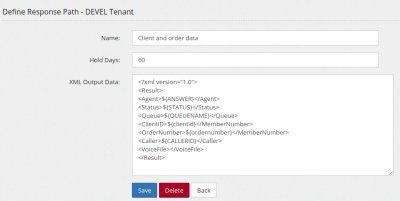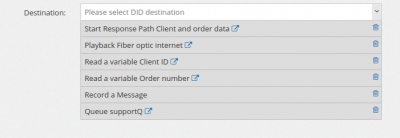Respone Paths: Difference between revisions
No edit summary |
No edit summary |
||
| Line 4: | Line 4: | ||
In this example, we are creating a client data collection response path for incoming calls. We can configure for how many days the results will be available in the system. After this number of days, the data will be automatically deleted. | In this example, we are creating a client data collection response path for incoming calls. We can configure for how many days the results will be available in the system. After this number of days, the data will be automatically deleted. | ||
In this destination we are going to start our response path and then collect the client number and the client order number. The call will be sent to a queue where the agent picking up the call can access the data inserted by the caller. | |||
[[file:responsapathsimpledestination.png|400px]] | |||
Revision as of 10:35, 4 November 2017
Sometimes you need to collect data from your callers, like "order number" or "client codes". Sometimes you need to collect multiple values and to be able to recover these pieces of information in a structured and consistent way. The object you have available is the "Response Path". When you place this object on your destination list, the system starts collecting START of calls, CALLERID, QUEUE used, VARIABLES read, extension ANSWERING and let these pieces of information available in the Status/Response Paths Logs page.
In this example, we are creating a client data collection response path for incoming calls. We can configure for how many days the results will be available in the system. After this number of days, the data will be automatically deleted.
In this destination we are going to start our response path and then collect the client number and the client order number. The call will be sent to a queue where the agent picking up the call can access the data inserted by the caller.

